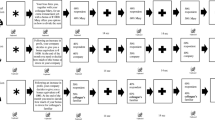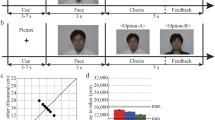Abstract
An individual’s economic valuation of a given object is biased by the moral status of the persons to whom the object is attached. The neural basis for how such “moral bias” occurs, especially how it is maintained in the resting state, are largely unknown. In the current study, we explored this question by correlating the functional connectivity with participants’ behavioral performance measured in a novel task which captured how the economic valuation was influenced by given moral information. Seed-based FC analysis showed that the functional connectivity between the mPFC and the orbital mPFC (omPFC), the mPFC and the precuneus, the mPFC and the left anterior cingulum, were significantly associated with the behavioral index of morality effect on economic valuation. Multivariate machine learning-based regression analysis showed that connections in the mPFC network, as well as in the putamen network could well predict the behavior performance, indicating that this mPFC network and the putamen network were crucial for this moral bias. Our results further revealed that the individuals’ personal trait of moral sensitivity served as a mediator between the rsFC of mPFC network and the behavioral index of morality effect on economic valuation.




Similar content being viewed by others
References
Bartra, O., McGuire, J. T., & Kable, J. W. (2013). The valuation system: A coordinate-based meta-analysis of BOLD fMRI experiments examining neural correlates of subjective value. Neuroimage, 76, 412–427.
Bhanji, J. P., & Beer, J. S. (2012). Taking a different perspective: Mindset influences neural regions that represent value and choice. Social Cognitive and Affective Neuroscience, 7, 782–793.
Biswal, B., Yetkin, F. Z., Haughton, V. M., & Hyde, J. S. (1995). Functional connectivity in the motor cortex of resting human brain using echo-planar MRI. Magnetic Resonance in Medicine, 34, 537–541.
Brosch, T., Coppin, G., Schwartz, S., & Sander, D. (2012). The importance of actions and the worth of an object: Dissociable neural systems representing core value and economic value. Social Cognitive and Affective Neuroscience, 7, 497–505.
Caceda, R., James, G. A., Gutman, D. A., & Kilts, C. D. (2015). Organization of intrinsic functional brain connectivity predicts decisions to reciprocate social behavior. Behavioural Brain Research, 292, 478–483.
Cavanna, A. E., & Trimble, M. R. (2006). The precuneus: A review of its functional anatomy and behavioural correlates. Brain, 129, 564–583.
Cole, M. W., Bassett, D. S., Power, J. D., Braver, T. S., & Petersen, S. E. (2014). Intrinsic and task-evoked network architectures of the human brain. Neuron 83, 238–251.
Cole, M. W., Ito, T., Bassett, D. S., & Schultz, D. H. (2016). Activity flow over resting-state networks shapes cognitive task activations. Nature neuroscience 19(12), 1718.
Cox, K. M., & Kable, J. W. (2014). BOLD subjective value signals exhibit robust range adaptation. The Journal of Neuroscience, 34, 16533–16543.
Crockett, M. J., Siegel, J. Z., Kurth-Nelson, Z., Dayan, P., & Dolan, R. J. (2017). Moral transgressions corrupt neural representations of value. Nat.Neurosci, 20, 879–885.
Cui, Z., & ong, G. (2018). The effect of machine learning regression algorithms and sample size on individualized behavioral prediction with functional connectivity features. NeuroImage., 178, 622–637.
Faul, F., Erdfelder, E., Lang, A. G., & Buchner, A. (2007). G*Power 3: A flexible statistical power analysis program for the social, behavioral, and biomedical sciences. Behavior Research Methods, 39, 175–191.
Fourie, M. M., Thomas, K. G., Amodio, D. M., Warton, C. M., & Meintjes, E. M. (2014). Neural correlates of experienced moral emotion: An fMRI investigation of emotion in response to prejudice feedback. Social Neuroscience, 9, 203–218.
Fox, M. D., & Raichle, M. E. (2007). Spontaneous fluctuations in brain activity observed with functional magnetic resonance imaging. Nature Reviews. Neuroscience, 8, 700–711.
Friston, K. J., Williams, S., Howard, R., Frackowiak, R. S., & Turner, R. (1996). Movement-related effects in fMRI time-series. Magnetic Resonance in Medicine, 35, 346–355.
Golland, P., & Fischl, B. (2003). Permutation tests for classification: Towards statistical significance in image-based studies. Inf. Process Med. Imaging, 18, 330–341.
Greene, J. D., Nystrom, L. E., Engell, A. D., Darley, J. M., & Cohen, J. D. (2004). The neural bases of cognitive conflict and control in moral judgment. Neuron, 44, 389–400.
Haidt, J. (2003). Elevation and the positive psychology of morality. In J. H. C. L. Keyes (Ed.), Flourishing: Positive psychology and the LifeWell-lived (pp. 275–289). Washington, DC: Am.Psychol. Assoc.
Han, H. (2017). Neural correlates of moral sensitivity and moral judgment associated with brain circuitries of selfhood: A meta-analysis. Journal of Moral Education, 46, 97–113.
Hastie, T., Tibshirani, R., & Friedman, J. H. (2001). The elements of statistical learning: Data mining, inference, and prediction. New York: Springer-Verlag.
Hood, B. M., Itajkura, S., Gjersoe, N. L., Byers, A., & Donnelly, K. (2011). Moral contagion attitudes towards potential organ transplants in British and Japanese adults. Journal of Cognition and Culture, 11, 269–286.
Huang, F. F., Yang, Q., Zhang, J., Zhang, Q. H., Khoshnood, K., & Zhang, J. P. (2016). Cross-cultural validation of the moral sensitivity questionnaire-revised Chinese version. Nursing Ethics, 23, 784–793.
Jung, W. H., Prehn, K., Fang, Z., Korczykowski, M., Kable, J. W., Rao, H., et al. (2016). Moral competence and brain connectivity: A resting-state fMRI study. Neuroimage., 141, 408–415.
Korponay, C., Pujara, M., Deming, P., Philippi, C., Decety, J., Kosson, D. S., et al. (2017). Impulsive-antisocial dimension of psychopathy linked to enlargement and abnormal functional connectivity of the striatum. Biol. Psychiatry Cogn Neurosci. Neuroimaging, 2, 149–157.
Kramer, T., & lock, L. (2011). Nonconscious effects of peculiar beliefs on consumer psychology and choice. Journal of Consumer Psychology, 21, 101–111.
Kuss, K., Falk, A., Trautner, P., Montag, C., Weber, B., & Fliessbach, K. (2015). Neuronal correlates of social decision making are influenced by social value orientation-an fMRI study. Frontiers in Behavioral Neuroscience, 9, 40.
Libedinsky, C., Smith, D. V., Teng, C. S., Namburi, P., Chen, V. W., Huettel, S. A., et al. (2011). Sleep deprivation alters valuation signals in the ventromedial prefrontal cortex. Frontiers in Behavioral Neuroscience, 5, 70.
Liu, J., ** good and evil in the Mind. New York: Guilford.
Miller, R. M. & Cushman, F. A. (2018). Moral values and motivations: How special are they? In in K. Gray & J. Graham (eds) (Ed.), The atlas of moral psychology: Map** good and evil .
Molenberghs, P., Gapp, J., Wang, B., Louis, W. R., & Decety, J. (2016). Increased moral sensitivity for outgroup perpetrators harming Ingroup members. Cerebral Cortex, 26, 225–233.
Moll, J., de Oliveira-Souza, R., Eslinger, P. J., Bramati, I. E., Mourao-Miranda, J., Andreiuolo, P. A., et al. (2002). The neural correlates of moral sensitivity: A functional magnetic resonance imaging investigation of basic and moral emotions. The Journal of Neuroscience., 22, 2730–2736.
Murphy, K., & Fox, M. D. (2017). Towards a consensus regarding global signal regression for resting state functional connectivity MRI. Neuroimage, 154, 169–173.
Newman, G. E., & Bloom, P. (2014). Physical contact influences how much people pay at celebrity auctions. Proceedings of the National Academy of Sciences of the United States of America, 111, 3705–3708.
Padoa-Schioppa, C. (2007). Orbitofrontal cortex and the computation of economic value. Annals of the New York Academy of Sciences, 1121, 232–253.
Park, S. Q., Kahnt, T., Rieskamp, J., & Heekeren, H. R. (2011). Neurobiology of value integration: When value impacts valuation. J.Neurosci., 31, 9307–9314.
Parkinson, C., Sinnott-Armstrong, W., Koralus, P. E., Mendelovici, A., McGeer, V., & Wheatley, T. (2011). Is morality unified? Evidence that distinct neural systems underlie moral judgments of harm, dishonesty, and disgust. J. Cognitive Neuroscience, 23, 3162–3180.
Power, J. D., Barnes, K. A., Snyder, A. Z., Schlaggar, B. L., & Petersen, S. E. (2012). Spurious but systematic correlations in functional connectivity MRI networks arise from subject motion. Neuroimage., 59, 2142–2154.
Preacher, K. J., & Hayes, A. F. (2008). Asymptotic and resampling strategies for assessing and comparing indirect effects in multiple mediator models. Behavior Research Methods, 40, 879–891.
Rademacher, L., Krach, S., Kohls, G., Irmak, A., Grunder, G., & Spreckelmeyer, K. N. (2010). Dissociation of neural networks for anticipation and consumption of monetary and social rewards. Neuroimage., 49, 3276–3285.
Rudorf, S., Baumgartner, T., Markett, S., Schmelz, K., Wiest, R., Fischbacher, U., et al. (2018). Intrinsic connectivity networks underlying individual differences in control-averse behavior. Human Brain Map**, 39, 4857–4869.
Russell, P. S., & Giner-Sorolla, R. (2013). Bodily moral disgust: What it is, how it is different from anger, and why it is an unreasoned emotion. Psychological Bulletin., 139, 328–351.
Sambataro, F., Dimalta, S., Di, G. A., Taurisano, P., Blasi, G., Scarabino, T., et al. (2006). Preferential responses in amygdala and insula during presentation of facial contempt and disgust. European Journal of Neurology, 24, 2355–2362.
Shenhav, A., & Greene, J. D. (2014). Integrative moral judgment: Dissociating the roles of the amygdala and ventromedial prefrontal cortex. J.Neurosci., 34, 4741–4749.
Spreckelmeyer, K. N., Krach, S., Kohls, G., Rademacher, L., Irmak, A., Konrad, K., et al. (2009). Anticipation of monetary and social reward differently activates mesolimbic brain structures in men and women. Social Cognitive and Affective Neuroscience, 4, 158–165.
Thielscher, A., & Pessoa, L. (2007). Neural correlates of perceptual choice and decision making during fear-disgust discrimination. The Journal of Neuroscience, 27, 2908–2917.
Tzourio-Mazoyer, N., Landeau, B., Papathanassiou, D., Crivello, F., Etard, O., Delcroix, N., et al. (2002). Automated anatomical labeling of activations in SPM using a macroscopic anatomical parcellation of the MNI MRI single-subject brain. Neuroimage, 15, 273–289.
Utevsky, A. V., Smith, D. V., & Huettel, S. A. (2014). Precuneus is a functional core of the default-mode network. J.Neurosci., 34, 932–940.
White, S. F., Zhao, H., Leong, K. K., Smetana, J. G., Nucci, L. P., & Blair, R. J. R. (2017). Neural correlates of conventional and harm/welfare-based moral decision-making. Cognitive, Affective, & Behavioral Neuroscience, 17, 1114–1128.
Winecoff, A., Clithero, J. A., Carter, R. M., Bergman, S. R., Wang, L., & Huettel, S. A. (2013). Ventromedial prefrontal cortex encodes emotional value. The Journal of Neuroscience, 33, 11032–11039.
Winston, J. S., Vlaev, I., Seymour, B., Chater, N., & Dolan, R. J. (2014). Relative valuation of pain in human orbitofrontal cortex. J.Neurosci., 34, 14526–14535.
Yan, C., & Zang, Y. (2010). DPARSF: A MATLAB toolbox for "pipeline" data analysis of resting-state fMRI. Frontiers in Systems Neuroscience, 4, 13.
Yan, C. G., Cheung, B., Kelly, C., Colcombe, S., Craddock, R. C., Di, M. A., et al. (2013). A comprehensive assessment of regional variation in the impact of head micromovements on functional connectomics. Neuroimage, 76, 183–201.
Yu, R., Calder, A. J., & Mobbs, D. (2014). Overlap** and distinct representations of advantageous and disadvantageous inequality. Human Brain Map**, 35, 3290–3301.
Zeki, S., & Romaya, J. P. (2008). Neural correlates of hate. PLoS One, 3, e3556.
Funding
This work was by the National Natural Science Foundation of China (no.31871109; no.31530031).
Author information
Authors and Affiliations
Contributions
Author contributions: F.C. and Y.L. designed the research; J.L and B.Y collected and analyzed data; J.L. and F.C wrote the paper. The authors declare no competing financial interests.
Corresponding author
Ethics declarations
Conflict of interest
No.
Ethical approval
The study was conducted according to the ethical guidelines and principles of the Declaration of Helsinki and was approved by the Medical Ethical Committee of Medical School in Shenzhen University, Shenzhen, China.
Informed consent
All participants provided written informed consent after they fully understood the procedures.
Additional information
Publisher’s note
Springer Nature remains neutral with regard to jurisdictional claims in published maps and institutional affiliations.
Electronic supplementary material
ESM 1
(DOCX 1058 kb)
Rights and permissions
About this article
Cite this article
Liu, J., Yuan, B., Luo, Yj. et al. Intrinsic functional connectivity of medial prefrontal cortex predicts the individual moral bias in economic valuation partially through the moral sensitivity trait. Brain Imaging and Behavior 14, 2024–2036 (2020). https://doi.org/10.1007/s11682-019-00152-1
Published:
Issue Date:
DOI: https://doi.org/10.1007/s11682-019-00152-1




